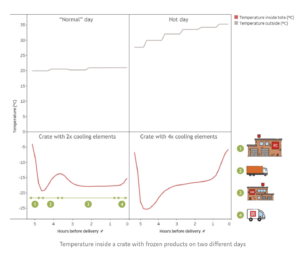Delivering fresh groceries to customers is a challenge, even more so in the summer months when ice cream needs to remain perfectly frozen and the outside temperature is above 30 degrees Celsius. To succeed in this challenge, Dutch e-groceries company Picnic has numerous operational processes in place. On their blog, Picnic Engineer Floris Boekema shares how they have set up the right processes by having visibility from start to end.
Preparing deliveries for consumers starts at the Picnic Fulfilment Center (FC). Here, fresh products are stored in two cold storage areas (chilled and frozen). Products are stored at the right temperature until they are picked in small crates for consumers.
From the moment the products leave the FC, they are exposed to outdoor temperatures. To prevent immediate temperature changes, the crates in which Picnic ships fresh products are insulated and have additional cooling elements inside. From the FC, products are shipped to different hubs by a large truck. Then they are loaded into delivery vehicles for last-mile delivery.
Measuring temperature every step of the way
Every day in each FC, a selection of crates gets a temperature log tag that measures the temperature throughout the day. After all products for the customer are picked, Picnic adds these tags to the crates using a handheld scanner. This scanner is linked to the Warehouse Management System (WMS). Then the journey to the consumer starts. Every 5 minutes, the inside temperature of the crate is measured throughout the delivery process.
The Data Warehouse (DWH) supports data analytics. The monitoring of product temperature provides important insights. Integrating data and making sense is a challenge. Beyond the tracking of the temperature, Picnic can combine these data with actual feedback from the customer. Picnic Engineer Floris Boekema: “If the customer reports that their ice cream was melted, we could track the product’s delivery path. Then we can pinpoint whether the root cause was the extremely hot weather, the cooling in the truck, the number of ice packs in the crate, or perhaps the lid was not tightly closed. This helps us act quickly and take systematic measures to improve in the future”.
From data to actionable insights
Having all data enables Picnic to validate the measures they take on different days. Operational guidelines are developed for adding two cooling elements to the crate on a ‘normal’ day versus four cooling elements on a ‘hot’ day. Each morning around 5 AM, a weather forecast message is automatically posted in Slack. By sticking to this heat plan, Picnic makes sure they provide enough cooling elements to the crate. Picnic is able to prevent a significant temperature increase at their locations because the FC and hubs are equipped with cold storage. When crates are shipped between locations, the temperature increases but not up to a point where the products start defrosting.
Source: Picnic

